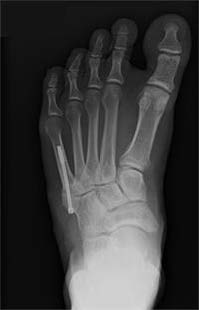
#FIFTH METATARSAL FULL#
How can I take care of myself?įollow the full course of treatment your healthcare provider prescribes. You may need to do special exercises to help your foot get stronger and more flexible. With treatment, most foot fractures take up to 6 weeks to heal. Use crutches, a knee walker, or a cane as directed by your healthcare provider. Your provider will tell you how much weight you can put on your foot, if any.
#FIFTH METATARSAL SKIN#
Avoid scratching the skin around the cast or poking things down between the cast and your skin. Cover the cast with plastic when you bathe.
#FIFTH METATARSAL CRACK#
The break may be just a bend or small crack in the bone, or the bone may break into pieces or shatter. It is a break or crack in the long foot bone that attaches to the little toe. Your doctor will discuss the type of procedure that may be needed for your condition.A fifth metatarsal fracture, also called a Jones fracture, is type of foot fracture. Surgery may include placing a screw to stabilize the fractured bone, and hold it securely in place while healing occurs and bone graft may be used to stimulate a healing response. If the fracture fails to unite, or heal, or if the injury involves a displaced bone, or multiple fractures, surgery will likely be recommended. This technique may be used if immobilization does not provide adequate healing.
#FIFTH METATARSAL FREE#
Bone stimulation is a technique for accelerating healing by using a pain free external device. Crutches may be recommended to keep you from putting weight on your leg. A cast, cast boot, or stiff-soled shoe may be needed to immobilize your foot. Initial treatment consists of rest, ice, compression, and elevation (RICE protocol) all assist in controlling pain and swelling. X-rays and other additional imaging studies may be needed. Your doctor will ask you about the symptoms, history of injury, and will examine your foot to determine the location of pain. If you injure your fifth metatarsal bone, you should seek medical attention as soon as possible for proper diagnosis and treatment. They may also have difficulty in walking. Patients who sustain a Jones fracture have pain, swelling, tenderness, and bruising over outside area of their foot. Overuse, repetitive stress and trauma are the most common causes of Jones fractures. Other fractures such as mid-shaft fractures, and fractures of the metatarsal head and neck may occur in the fifth metatarsa.

These fractures are less common than those of avulsion fractures and may take longer to heal. It can either be a stress fracture (a small hairline break that occurs over time) or an acute (sudden) break.

Jones fracture involves fracture in a small area of the fifth metatarsal that receives limited blood supply. In avulsion fracture, a piece of the bone is pulled off the main portion of the fifth metatarsal by the tendon that attaches to this region. There are two types of fractures that often occur in the fifth metatarsal, avulsion fracture and Jones fracture. The fifth metatarsal bone is more commonly fractured. The fifth metatarsal is the long bone that is located on the outside of the foot and connects to the small toe. There are five metatarsal bones in each foot. The metatarsal bones are the long bones in your feet.


 0 kommentar(er)
0 kommentar(er)
